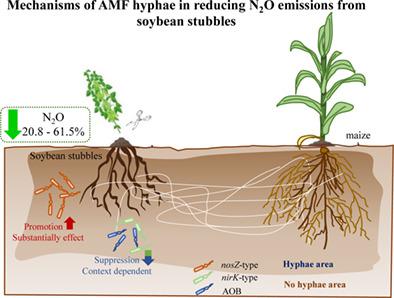当前位置:
X-MOL 学术
›
Environ. Microbiol.
›
论文详情
Our official English website, www.x-mol.net, welcomes your
feedback! (Note: you will need to create a separate account there.)
Enrichment of nosZ-type denitrifiers by arbuscular mycorrhizal fungi mitigates N2O emissions from soybean stubbles
Environmental Microbiology ( IF 4.3 ) Pub Date : 2021-10-20 , DOI: 10.1111/1462-2920.15815 Ruotong Zhao 1 , Xia Li 1, 2 , Shuikuan Bei 1 , Dandan Li 1 , Haigang Li 3 , Peter Christie 1 , S Franz Bender 4 , Junling Zhang 1
Environmental Microbiology ( IF 4.3 ) Pub Date : 2021-10-20 , DOI: 10.1111/1462-2920.15815 Ruotong Zhao 1 , Xia Li 1, 2 , Shuikuan Bei 1 , Dandan Li 1 , Haigang Li 3 , Peter Christie 1 , S Franz Bender 4 , Junling Zhang 1
Affiliation

|
Hotspots of N2O emissions are generated from legume residues during decomposition. Arbuscular mycorrhizal fungi (AMF) from co-cultivated intercropped plants may proliferate into the microsites and interact with soil microbes to reduce N2O emissions. Yet, the mechanisms by which or how mycorrhizal hyphae affect nitrifiers and denitrifiers in the legume residues remain ambiguous. Here, a split-microcosm experiment was conducted to assess hyphae of Rhizophagus aggregatus from neighbouring maize on overall N2O emissions from stubbles of nodulated or non-nodulated soybean. Soil microbes from fields intercropped with maize/soybean amended with fertilizer nitrogen (SS-N1) or unamended (SS-N0) were added to the soybean chamber only. AMF hyphae consistently reduced N2O emissions by 20.8%–61.5%. Generally, AMF hyphae promoted the abundance of N2O-consuming (nosZ-type) denitrifiers and altered their community composition. The effects were partly associated with increasing MBC and DOC. By contrast, AMF reduced the abundance of nirK-type denitrifiers in the nodulated SS-N0 treatment only and that of AOB in the non-nodulated SS-N1 treatment. Taken together, our results show that AMF reduced N2O emissions from soybean stubbles, mainly through the promotion of N2O-consuming denitrifiers. This holds promise for mitigating N2O emissions by manipulating the efficacious AMF and their associated microbes in cereal/legume intercropping systems.
中文翻译:

丛枝菌根真菌富集 nosZ 型反硝化菌可减少大豆茬 N2O 排放
N 2 O 排放的热点是豆类残留物在分解过程中产生的。来自共同栽培的间作植物的丛枝菌根真菌(AMF)可能会增殖到微场所并与土壤微生物相互作用以减少N 2 O排放。然而,菌根菌丝影响豆类残留物中硝化菌和反硝化菌的机制仍然不明确。在这里,进行了分裂微观世界实验,以评估来自邻近玉米的聚合根瘤菌菌丝对来自结节或非结节大豆残茬的 N 2 O 排放总量的影响。来自间作玉米/大豆的田地的土壤微生物仅添加到大豆室中,其中经氮肥改良(SS-N1)或未改良(SS-N0)。 AMF 菌丝持续减少 N 2 O 排放量 20.8%–61.5%。一般来说,AMF菌丝促进了消耗N 2 O( nosZ型)反硝化菌的丰度并改变了它们的群落组成。这种影响部分与 MBC 和 DOC 的增加有关。相比之下,AMF 仅降低了结瘤 SS-N0 处理中nirK型反硝化菌的丰度,以及非结瘤 SS-N1 处理中 AOB 的丰度。综上所述,我们的结果表明,AMF 主要通过促进消耗 N 2 O 的反硝化菌来减少豆茬中的 N 2 O 排放。这有望通过在谷物/豆类间作系统中操纵有效的 AMF 及其相关微生物来减少 N 2 O 排放。
更新日期:2021-11-26
中文翻译:

丛枝菌根真菌富集 nosZ 型反硝化菌可减少大豆茬 N2O 排放
N 2 O 排放的热点是豆类残留物在分解过程中产生的。来自共同栽培的间作植物的丛枝菌根真菌(AMF)可能会增殖到微场所并与土壤微生物相互作用以减少N 2 O排放。然而,菌根菌丝影响豆类残留物中硝化菌和反硝化菌的机制仍然不明确。在这里,进行了分裂微观世界实验,以评估来自邻近玉米的聚合根瘤菌菌丝对来自结节或非结节大豆残茬的 N 2 O 排放总量的影响。来自间作玉米/大豆的田地的土壤微生物仅添加到大豆室中,其中经氮肥改良(SS-N1)或未改良(SS-N0)。 AMF 菌丝持续减少 N 2 O 排放量 20.8%–61.5%。一般来说,AMF菌丝促进了消耗N 2 O( nosZ型)反硝化菌的丰度并改变了它们的群落组成。这种影响部分与 MBC 和 DOC 的增加有关。相比之下,AMF 仅降低了结瘤 SS-N0 处理中nirK型反硝化菌的丰度,以及非结瘤 SS-N1 处理中 AOB 的丰度。综上所述,我们的结果表明,AMF 主要通过促进消耗 N 2 O 的反硝化菌来减少豆茬中的 N 2 O 排放。这有望通过在谷物/豆类间作系统中操纵有效的 AMF 及其相关微生物来减少 N 2 O 排放。











































 京公网安备 11010802027423号
京公网安备 11010802027423号